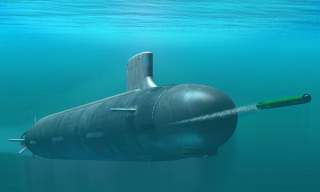Is South Korea Getting Ready to Build Nuclear Submarines?
It might not be so easy.
With North Korea developing a nuclear-armed ballistic missile submarine, South Korea is contemplating the development of a nuclear-powered attack submarine (SSN). However, the Republic of Korea faces a long, difficult and expensive path to acquiring such a capability should Seoul choose to embark on such a journey.
“The party stressed that securing a nuclear sub is an urgent task to overcome the North's asymmetric capabilities and strengthen self-defense,” Rep. Kim Gwang-lim, chief policymaker for the ruling Saenuri Party told reporters according to Korea Times. “The government vowed to seriously consider the suggestion.”
The South Korean government believes that it needs an SSN to counter Pyongyang’s nascent ballistic missile submarine program. The reasoning in Seoul is that a conventional diesel-electric—or even one with Air Independent Propulsion—would not have the persistence to maintain continuous tracking of the North Korean boomers.
However, while South Koreans might want a nuclear attack submarine, such vessels are extremely expensive and technically challenging to develop and build. It is highly unlikely that the United States would sell a Virginia-class attack submarine to South Korea, nor is it likely that Seoul could afford to operate such vessels. Thus, the mostly likely option would be for South Korea to develop its own indigenous SSNs.
But to accomplish such a feat, Seoul would almost certainly require technical assistance from the United States, which might not be willing to transfer extremely sensitive submarine technology to South Korea. But even with American technical assistance, developing an SSN is extremely expensive and difficult in the best of times. Even Great Britain, which had previous nuclear submarine experience, required American help to develop the Astute-class SSN and the Successor-class SSBN.
A further challenge is that Washington effectively controls most uranium enrichment and nuclear fuel reprocessing for South Korea. The current agreement between Seoul and Washington does not allow for South Korea to use American-sources of uranium for military purposes. “The two countries have yet to review whether or not the revision would allow South Korea to secure uranium necessary for a nuclear submarine,” a Korean defense ministry official told the Korea Times on the condition of anonymity.
Another potential option for South Korea would be to approach France for help in developing a nuclear submarine. The French are generally more open in sharing their submarine technology. Indeed, France had offered to develop a conventionally-powered version of their Barracuda-class SSN for Australia. However, French SSNs are not quite up to par with American or British attack submarines. Meanwhile, neither Russia nor China are likely to offer their SSN technology to Seoul even if South Korea were so inclined.
Indeed, one of the potential complications arising from South Korean-owned nuclear attack submarines would be the reaction from China, Russia and, potentially, Japan. Moscow and especially Beijing are likely to react with fury over the prospect of Korean SSNs roaming in the Western Pacific.
Dave Majumdar is the defense editor for The National Interest. You can follow him on Twitter: @davemajumdar.

